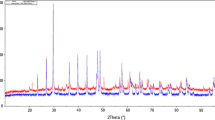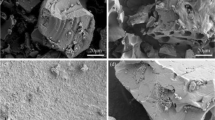Abstract
Total iron is one of the problematic contaminants existing in the landfill leachate, which may lead to both ground and surface water pollution. This study was conducted to find out the potential of a low-cost composite adsorbent (COM) to treat total iron in landfill leachate using batch sorption experiments. The COM was composed mainly of brick-and-mortar waste and biochar with small amounts of granular activated carbon (GAC) and natural zeolite. Both kinetic and adsorption isotherm experiments were conducted for the COM as well as for its ingredients individually, to optimize the contact time and mass of the adsorbent, respectively. The removal efficiency of the COM was 95.0%, whereas that of high-cost zeolite and GAC were 89.7% and 93.0%, respectively. The initial total iron concentration, stirring speed, temperature, and initial pH were optimized for the COM. The total iron removal efficiency increased with the increment of the initial total iron concentration, stirring speed and temperature, and the reduction of the initial pH of the influent. Finally, a verification test was conducted with the COM at the optimum conditions. Four replicates were tested. All the replicates gave an average removal efficiency of 99.2 %. The average adsorption capacity was 1.3 mg/g, and the measurements were fitted the best with a Langmuir isotherm model with R2 equal to 1. Hence, the COM has the potential to be applied as a reactive/packing medium in any treatment process of landfill leachate or wastewater of the similar characteristics as landfill leachate.















Similar content being viewed by others
Data Availability
The datasets generated during and/or analyzed during the current study are available from the corresponding author upon reasonable request.
References
Alrumman, S. A., El-kott, A. F., & Keshk, S. M. (2016). Water pollution: Source & treatment. American Journal of Environmental Engineering, 6(3), 88–98.
Aziz, H. A., Othman, N., Yusuff, M. S., Basri, D. R. H., Ashaari, F. A. H., Adlan, M. N., Othman, F., & Johari, & M., Perwira, M. (2001). Removal of copper from water using limestone filtration technique determination of mechanism of removal. Environment International, 26(5-6), 395–399. https://doi.org/10.1016/s0160-4120(01)00018-6
Benerjee, S., LaminKa-ot, A., Joshi, S. R., Mandal, T., & Gopinath, H. (2017). Optimization of Fe removal from coal mine wastewater using activated biochar of Colocasia esculenta. Water Environment Research, 89(9), 774–782. https://doi.org/10.2175/106143017X14902968254791
Chemistry of iron in natural water. (1962). Geological survey water supply paper 1459. United States Government Printing Office.
Clesceri, L. S., Greenberg, A. E., & Eaton, A. D. (1998). Standard methods for the examination of water and wastewater (pp. 20005–22605). American Public Health Association. https://doi.org/10.3390/w12061614
Duwiejuah, A. B., Cobbina, S. J., & Bakobie, N. (2017). Review of eco-friendly biochar used in the removal of trace metals on aqueous phases. International Journal of Environmental Bioremediation & Biodegradation, 5(2), 27–40. https://doi.org/10.12691/ijebb-5-2-1
Fierro, V., Torné-Fernández, V., Montané, D., & Celzard, A. (2008). Adsorption of phenol onto activated carbons having different textural and surface properties. Microporous and Mesoporous Materials, 111(1-3), 276–284. https://doi.org/10.1016/j.micromeso.2007.08.002
Gunathilake, S. K. (2015). Methods of removing heavy metals from industrial wastewater. Journal of Multidisciplinary Engineering Science Studies, 1, 12–18.
Halim, A. A., Aziz, H. A., Johari, M. A., & Ariffin, K. S. (2010). Comparion study of ammonia and COD adsorption on zeolite, activated carbon and composite materials in landfill leachate treatment. Desalination, 31–33. https://doi.org/10.12911/22998993/153005
Ismail, A., Harmuni, H., & Mohd, R. R. M. (2017). Removal of iron and manganese using granular activated carbon and zeolite in artificial barrier of riverbank filtration. AIP Conference Proceedings (1835, 1, p. 020056). AIP Publishing LLC. https://doi.org/10.1063/1.4983796.
Jun, D., Yongsheng, Z., Weilhong, Z., & Mei, H. (2009). Laboratory study on sequences PRB remediation for landfill leachate contaminated ground water. Journal of Hazardous Material, 161(1), 224–230. https://doi.org/10.1016/j.jhazmat.2008.03.086
Kumar, P. S., Vincent, C., Kirthika, K., & Kumar, K. S. (2010). Kinetics and equilibrium studies of Pb2+ in removal from aqueous solutions by use of nano-silversol-coated activated carbon. Brazilian Journal of Chemical Engineering, 27(2), 339–346.
Kumar, S., Katoriaand, D., & Singh, G. (2013). Leachate treatment technology. International Journal of Environmental Engineering and Management, 4(5), 439–444.
Mohamed, A. M. O., & Antia, H. E. (1998). Geoenvironmental Engineering, Developments In Geotechnical Engineering (pp. 330–548). 82, Elsevier Science B.V.
Morgan, B., & Lahav, O. (2007). The effect of pH on the kinetics of spontaneous Fe (II) oxidation by O2 in aqueous solution – basic principles and a simple heuristic description. Chemosphere, 68(11), 2080–2084. https://doi.org/10.1016/j.chemosphere.2007.02.015
Neag, E., Török, A. I., Tanaselia, C., Aschilean, L., & Senila, M. (2020). Kinetics and equilibrium studies for the removal of Mn and Fe from binary metal solution systems using a Romanian thermally activated natural zeolite. Water, 12(6), 1614.
Raheem, S. A., Kadhim, E. J., & Abdulhasan, M. J. (2022). Comparative study of iron removal from groundwater using low cost adsorbents. Journal of Ecological Engineering, 23(11), 18–23.
Sazali, N., Harun, Z., & Sazali, N. (2020). A review on batch and column adsorption of various adsorbent towards the removal of heavy metal. Journal of Advanced Research in Fluid Mechanics and Thermal Sciences, 67(2), 66–88.
Tan, X., Liu, Y., Zeng, G., Wang, X., Hu, X., Gu, Y., & Yang, Z. (2015). Application of biochar for the removal of pollutants from aqueous solutions. Chemosphere, 125, 70–85. https://doi.org/10.1016/j.chemosphere.2014.12.058
Thinojah, T., & Ketheesan, B. (2022). Iron removal from groundwater using granular activated carbon filters by oxidation coupled with the adsorption process. Journal of Water and Climate Change, 13(5), 1985–1994. https://doi.org/10.2166/wcc.2022.126
Thiruvenkatachari, R., Vigneswaran, S., & Naidu, R. (2008). Permeable reactive barrier for ground water remediation: A review. Journal of Industrial and Engineering Chemistry, 14(2), 145–156. https://doi.org/10.1016/j.jiec.2007.10.001
Vinayakamoorththy, K., & Dayanthi, W. K. C. N. (2019). Batch sorption experiments on recycling building waste to treat total iron in landfill – leachate. Engineer: Journal of the Institution of Engineers, Sri Lanka, 52(4), 29–36. https://doi.org/10.4038/engineer.v52i4.7391
Wang, Y., Pleasant, S., Jain, P., Powell, J., & Townsend, T. (2016). Calcium carbonate-based permeable reactive barriers for iron and manganese groundwater remediation at landfills. Waste Management, 53, 128–135. https://doi.org/10.1016/j.wasman.2016.02.018
Zhao, G., Wu, X., Tan, X., & Wang, X. (2011). Sorption of heavy metal ions from aqueous solutions: A review. The Open Colloid Science Journal, 4, 19–31.
Zhou, D., Li, Y., Zhang, Y., Zhang, C., Li, X., Chen, Z., Huang, J., Li, X., Flores, G., & Kamon, M. M. (2014). Column test-based optimization of the permeable reactive barrier (PRB) technique for remediating groundwater contaminated by landfill leachates. Journal of Contaminant Hydrology, 168, 1–16. https://doi.org/10.1016/j.jconhyd.2014.09.003
Acknowledgements
The technical officer, Ms. D. A. M. Nimal Shanthi in the Department of Civil and Environmental Engineering, Faculty of Engineering, University of Ruhuna, Sri Lanka is greatly acknowledged.
Author information
Authors and Affiliations
Corresponding author
Ethics declarations
Competing Interests
The authors declare no competing interests.
Additional information
Publisher’s Note
Springer Nature remains neutral with regard to jurisdictional claims in published maps and institutional affiliations.
Rights and permissions
Springer Nature or its licensor (e.g. a society or other partner) holds exclusive rights to this article under a publishing agreement with the author(s) or other rightsholder(s); author self-archiving of the accepted manuscript version of this article is solely governed by the terms of such publishing agreement and applicable law.
About this article
Cite this article
Dayanthi, W.K.C.N., Piyanu, P. & Kumara, K.K.P.S. Batch Sorption Experiments on Low-Cost Composite Adsorbent to Treat Total Iron in Landfill Leachate. Water Air Soil Pollut 234, 283 (2023). https://doi.org/10.1007/s11270-023-06291-y
Received:
Accepted:
Published:
DOI: https://doi.org/10.1007/s11270-023-06291-y




